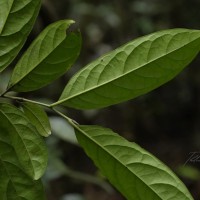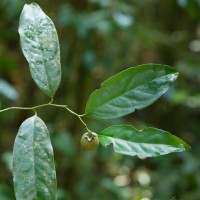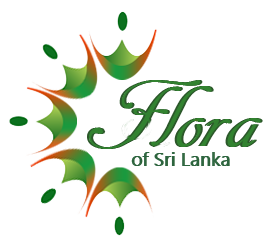
Small tree, up to 6 m high and 10 cm diam., rarely up to 15m high and 20 cm diam., dioecious and polygamous, fruiting already when 3 m high and 3 cm diam. Bark black, finely fissured, strips 2 cm wide, 0.5 mm thick. Live bark straw-yellow, 2 mm, with yellow sap. Wood white. Branchlets rather slender with apically a rather dense tomentum of adpressed hairs. Buds densely, coarsely sericeous. Cut branches turn immediately dark yellow inside. Leaves chartaceous to thinly coriaceous, glabrous, drying brownish-green, oblong, ovate-oblong to lanceolate-oblong, 2.5 x 6-6 x 18 (-9 x 22) cm, distinctly acuminate; acumen often long; base acute, slightly decurrent into petiole; both surfaces very laxly, prominulously, rather obscurely reticulate; above midrib slender, impressed, the surface glossy, slightly wrinkled (dry), lateral nerves very slender, prominulous (often in a groove); below less glossy, midrib slender, prominent, laterals 6-8 pairs, erect-patent, arcuate. Petiole slender, 7-20 mm, soon glabrous, channelled above. Flowers in polygamous trees are: a) with short, accrescent calyx lobes, fertile anthers, abortive pistil, b) with large, deltoid calyx lobes with straight or recurved margins, fertile anthers, abortive pistil, c) with large deltoid calyx segments, with deep intersegmental grooves, fertile anthers, fertile pistil. The enlarged, recurved calyx lobes are an indication of hermaphroditism, but this character is not always present and occurs also in female flowers. Male and hermaphrodite flowers occur separately or in the same inflorescence. Male inflorescence sessile or subsessile pubescent cymes, initially as a red densely pilose bud in a leaf axil with or without peduncle, bearing decussate bracts. The first flower on a peduncle up to 10 mm long, others always sessile. Calyx green, campanulate with neck at base, inside sericeous, 5 mm long, outside very minutely brown pilose. Lobes 4, deltoid, acuminate, margin straight or slightly recurved, 3 mm long. Corolla yellow or white, in buds conical, 10-13 mm long; tube inflated, densely sericeous. Lobes 4, half the tube length, patent, inside glabrous. Stamens 12-16, epipetalous or monadelphous and hypogynous, single or in pairs, inner whorl shorter; anthers slender, apiculate, glabrous or somewhat pilose. Pistil none or a flat disc, showing compartments in cross section. Female flower solitary, axillary, sessile or nearly so. Peduncle 4 mm, with 4 decussate bracts without flowers. Calyx green, widely campanulate, very minutely brown-adpressed-pilose, thick. Lobes 4 (rarely 3), thick, deltoid, 1 cm long, conspicuously, sharply acuminate, margin slightly recurved laterally so as to form a ridge projecting outwards and downwards. Corolla white or yellow. Tube tubular, 15 mm long, densely sericeous. Lobes strongly reflexed or patent, 7-10 mm long. Staminodes 8, epipetalous, 5 mm long, filaments 3 mm, pilose, adnate to corolla tube at base. Ovary globose, densely sericeous, 8-celled; style 5 mm, stigmas 3-4. Fruit yellowish, glabrescent, depressed globose, apiculate, up to 2.5 cm high, 3.5 cm diam., smooth, glossy. Calyx tube hemispherical, 1 cm or more deep, up to 3 cm diam., thick with thin rim, which is either entire or slightly wavy (the lobes) and then these with a very narrow recurved lateral margin, showing the densely sericeous inner side of the calyx. Seeds 8, thin, up to 18 mm long; testa brown, smooth; endosperm equable. Seedling epigeal; cotyledons persistent; epicotyledonary system late in development. (FOC)
Diospyros gardneri Thw.
.jpg)
.jpg)
.jpg)
.jpg)
.jpg)
.jpg)
.jpg)
.jpg)
.jpg)
.jpg)


.jpg)
.jpg)
.jpg)
.jpg)
.jpg)
.jpg)
.jpg)
.jpg)
.jpg)
.jpg)


